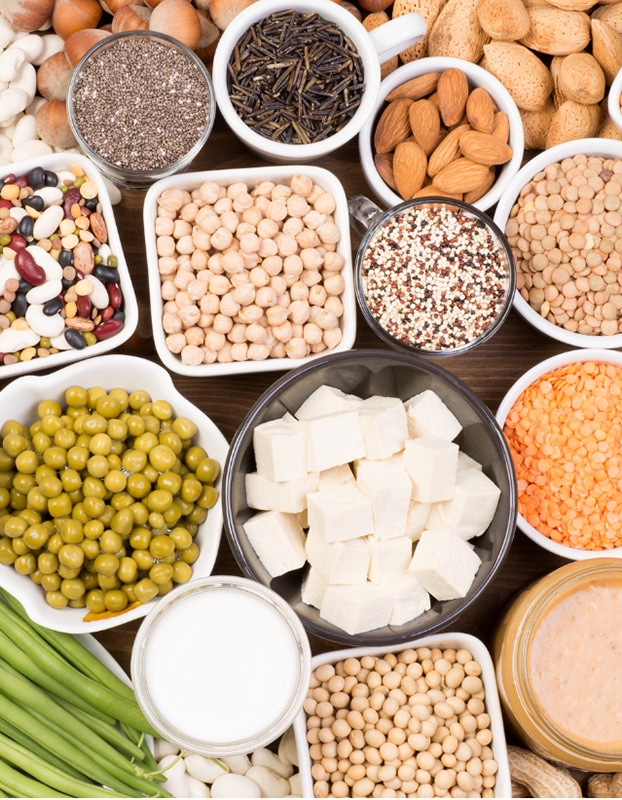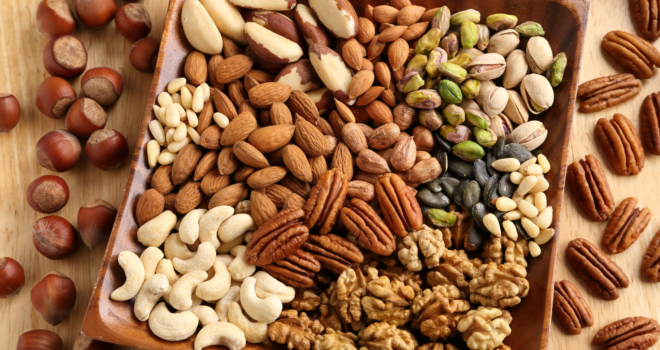Nuts, such as walnuts, hazelnuts, almonds, and peanuts, are rich in nutrients with proven health benefits. Except in cases of a confirmed allergy, they can contribute to a balanced diet… though in moderation, as they are very energy-dense!
Not used to eating nuts? You’re not alone. In Europe, 95% of the population does not consume them daily (1). Yet these foods—such as almonds, pistachios, walnuts, and hazelnuts—are bursting with health benefits. Easy to incorporate into your diet, they can enhance your meals from breakfast to dinner.
What are nuts?
They are called “nuts” because they have a hard, inedible shell that must be removed before eating. These fruits come from trees or shrubs growing in Europe, the Americas, or Asia: walnuts, hazelnuts, almonds, pistachios, cashews, pecans, Brazil nuts, macadamia nuts, etc.
Read also : Bright ideas for a more plant-based plate, without changing our menus!
What about peanuts?
Botanically, they are classified as legumes—like peas or beans. However, they are considered nuts due to their nutritional profile and mode of consumption.
Nutritional benefits under the shell
What are the key nutritional features of these valuable nuts?
- They contain a significant amount of protein (15–20%), with an amino acid profile suited to the nutritional needs of growing children who require these “building blocks” to develop their muscles.
- They provide particularly interesting fats, as they are primarily composed of unsaturated fatty acids that help regulate blood cholesterol levels (2).
- They are rich in minerals, notably calcium (100 g of walnuts cover 10% of daily requirements; 100 g of almonds, 25%!) and magnesium (100 g of nuts supply about one-quarter of an adult’s daily needs).
Consume them in moderation but regularly: about 30 g per day—that is, roughly 10–15 almonds or 3–4 walnuts. They are very energy-dense because they are rich in fats! Remember, many of these nuts are also used to produce oils (walnut oil, peanut oil, hazelnut oil, almond oil…).
For example, 30 g of almonds provide approximately 6 g of protein (around 10% of daily needs), 13 g of unsaturated fatty acids, and 80 mg of calcium (8–10% of daily needs).
This specific composition may explain why, in several epidemiological studies, nut consumption is associated with beneficial effects on hypertension, type 2 diabetes, cardiovascular diseases, inflammation… and even reduced mortality (3)!
How can such health effects be explained? Their richness in fiber, vitamin E, and minerals may help lower blood sugar levels and modulate insulin secretion, reducing the risk of diabetes. Their contributions of vitamin E, minerals (magnesium, selenium, and zinc), and polyphenols may account for their anti-inflammatory and antioxidant properties (4). The presence of both fiber and fats also explains their satiating effect (a small handful is enough to stave off hunger for several hours).
Recipe ideas for using nuts
Since they are beneficial for your health, how can you add more nuts to your menu? Good news—it’s very simple, as they can be easily added to any meal or snack during the day:
- At breakfast: Opt for a muesli rich in chopped hazelnuts or almonds, or add a handful to your morning yogurt.
- As a snack: A small handful of walnuts or almonds is both healthy and easy to take with you.
- At lunch: Adding walnuts to a salad provides crunch and a hint of bitterness that pairs perfectly with a vinaigrette or with blue or hard cheese.
Note: Oilseeds like sunflower, pumpkin, or sesame seeds have nutritional properties similar to nuts—try them to diversify flavors, textures, and tastes! For example, sesame paste (tahini) can be used in sauces, cakes, or spread on toast at breakfast.
Nuts and allergies
Nuts and peanuts are among the “major allergens.” In children, cashews and hazelnuts are the most problematic. There is often a cross-allergy between nuts, peanuts, and sesame (5). In France, 32% of allergic children are allergic to nuts. In Europe, approximately 1.6% of children are allergic to peanuts (6). These allergies have increased significantly in recent years.
References:
[1] Guinard JX et al. (2016).
[2] INRAE – Les racines d’une alimentation durable.
[3] Petersen KS et al. (2024).
[4] Escadeillas M et al. (2020)



 Parsley
Parsley  White beans
White beans  Vegetable garden: growing leek
Vegetable garden: growing leek 









